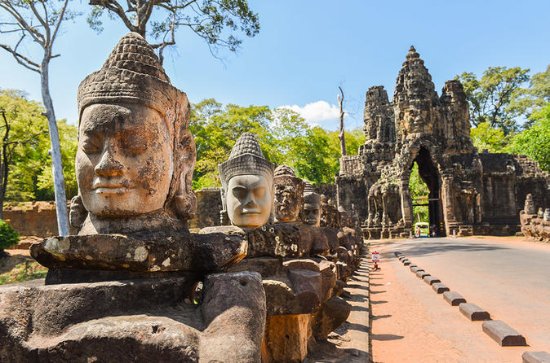
Although officially part of the Angkor complex, Banteay Srei lies 25 km (15 miles) north-east of the main group of temples, and therefore often considered a separate Cambodia attraction. The temple was completed in 967 AD and is built largely of red sandstone, a medium that lends itself to the elaborate decorative wall carvings which are still clearly visible today. Banteay Srei is the only major temple at Angkor not built for a king, instead it was constructed by one of king Rajendravarman’s counselors, Yajnyavahara.
Phnom Kulen
Phnom Kulen, or Kulen Mountain in Siem Reap province, offers a great day trip away from Angkor. The sacred site doubles up as a national park and is especially popular with Khmers during religious holidays, when offerings are left at the hilltop temple. The area is also home to two waterfalls for swimming, picnic areas, and Kbal Spean, an archaeological spot where The River of a Thousand Lingas is located.
Looking for Siem Reap Airbnb?
The laidback riverine town of Kampot has oodles of old world ambience. The compact central district is a joy to ramble around; full of surviving shop-house architecture, some of which has been painstakingly restored. Kampot’s charm lies in its exceedingly chilled out atmosphere, and many a traveler finds themselves waylaid here longer than they expected, having succumbed to its easygoing pace. For the more active though, this is also an excellent base for discovering the surrounding sights of the south. The old French summer getaway of Bokor Hill Station, with its abandoned church and eerie, empty shell of an once-grand hotel, is an easy day trip from town, as are the limestone caves of Phnom Chhnork and Phnom Sorsia, both with old temples inside.
Tonle Sap is Cambodia’s most important waterway and Southeast Asia’s largest freshwater lake. As well as being an important source of food and a vital tool for Cambodian irrigation, the lake itself is home to 170 floating villages that depend on fishing for their livelihood, with homes built directly on the water. The houses, shops, churches, schools, and temples of these villages are built on rustic buoy foundations of lashed together barrels and bamboo, and all transport is by boat. They’re a fascinating place to spend a day exploring. One of the most interesting is the sprawling village of Kompong Luong, near the town of Pursat on Tonle Sap’s western shore, although the most popular village to visit is Chong Kneas near Siem Reap.
If you are looking for a serene place that offers you myriad natural attractions under one roof, Tonle Sap Lake, or the “Great Lake” in Siem Reap, Cambodia is the perfect place. Here you can experience the various ecologically rich elements in their full forms. The place is also famous for its floating villages and migratory birds.
Highlights – With a maximum length of 250km, this is the biggest freshwater lake in Southeast Asia. During 1997, this place was designated as an UNESCO Biosphere Reserve. This is probably the only place in Cambodia where you can witness close to 100 types of water birds and 200 species of fishes.
Location – Lower Mekong Basin.
Timings – All through the year.
Price – There are various lake tours available to take tourists through Tonle Sap. Prices differ as per the routes and time covered. A basic lake tour starts from around USD29 onwards.